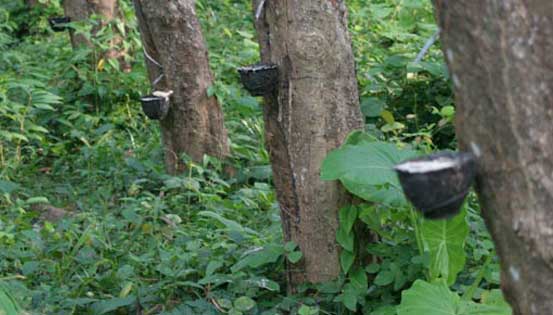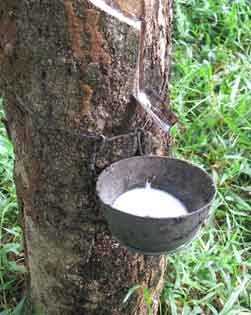An indispensable product to modern society as steel, wood and mortar is rubber. Rubber is of two types—natural and manmade. All of us use products made of rubber at home, at work, at play and even when we travel. Automobiles, trains, aircraft, industries rely on it for variety of purpose. That is why it is rightly said that rubber in the modern world is omnipotent.
What is rubber, exactly and where does it come from?Rubber is a yellowish, elastic, amorphous material obtained from the latex or milky sap of various tropical plants like the rubber tree. This latex is vulcanized, pigmented, finished and modified into various products like electric insulation, elastic bands, belts, tires, hoses, gaskets and containers. Rubber is also known by its scientific name “caoutchouc” or India rubber.
Ancient RubberThe exact origin of rubber is not known. The indigenous people of the Americas had known and used rubber long before the arrival of European explorers. Rubber makers in ancient Mesoamerica were almost 3,500 years ahead of Charles Goodyear and his vulcanized rubber. The ancient Mayan people used latex to make rubber balls which were used in an important ritual game. This game was called Tlachtlic, a cross between football and basketball, but had religious significance. This was recorded in the Popul Vuh, a Mayan religious document.


In 1525, a person called Padre d'Anghieria reported that he had seen Mexican tribespeople playing with elastic balls. An eraser was considered to be the first use for rubber. This was suggested by Magellan, a descendent of the famous Portuguese navigator. It was popularized in England by someone called Priestley and it became known as India Rubber. The Portuguese meaning of rubber is borracha and this originated from making jars replacing the leather borrachas that the Portuguese used to ship wine.
In 1735, the first scientific study of rubber was undertaken by Charles de la Condamine. According to him, rubber could be used to produce flexible tubes. Since then, there were many craftsmen who become involved with rubber. In 1820, Nadier, a British industrialist produced rubber threads and attempted to use them in clothing accessories. This was the time when America was seized by rubber fever, and there was the waterproof footwear used by the indigenous people which became a success. Snow boots and waterproof fabrics were produced in New England.
In 1832, the Rosburg factory was set up which unfortunately did not do well as cold weather affected goods produced from non-vulcanized natural rubber, leaving them brittle and thereby discouraging consumers.
Vulcanized RubberAfter a long period trying to develop a process to upgrade rubber qualities that almost ruined him, Goodyear discovered vulcanization, quite by accident in 1840. Till 1839, rubber was subject to the change in weather conditions. The rubber was hot and sticky during hot weather. It became cold and brittle during cold weather. Goodyear discovered the process vulcanization when a mixture of rubber, lead and sulfur were accidentally dropped onto a hot stove. This resulted in a product which wasn't affected by weather, and which came back to its original form if stretched. The process was refined and thereby the uses for rubber materials increased. This new vulcanized rubber was resistant to water and chemical interactions and did not conduct electricity, and hence suitable for a variety of products.
Modern rubberToday more than 75% of rubber in production is a synthetic product made from crude oil. During World War II, the United States could not supply rubber worldwide, and they stepped up production of synthetic rubber for use in the war effort. There are about 20 grades of synthetic rubber and ultimately it is the intended end use which determines selection. Natural rubber is just one kind. Because the rubber plant only thrives in hot, damp regions near the equator, the principal countries where there is 90% of true rubber production today is the Southeast Asian countries of Malaysia and Thailand and Indonesia. However, Indonesia's production has dropped in recent years and new rubber plantations were started in Africa to take up the slack.
Today there is not just one substance or a product called rubber. Rubber belongs to a class, made up of a number of materials that have the unique property of high elasticity.
- Anti Vibration Mountings
- Automobile Rubber Products
- Calendered Rubber Products
- Extruded Rubber Products
- Medical Rubber Products
- Metal Bonded Components
- Rubber Adhesives & Sealants
- Rubber Ball
- Rubber Bands
- Rubber Beading
- Rubber Bearing
- Rubber Belt
- Rubber Buckets
- Rubber Bullets
- Rubber Cable
- Rubber Coating
- Rubber Duct
- Rubber Expansion Joints
- Rubber Flooring/Matting
- Rubber Footwear
- Rubber Gloves
- Rubber Injection Parts
- Rubber Lining
- Rubber Magnets
- Rubber Molded Products
- Rubber Pads
- Rubber Rollers
- Rubber Stopper
- Rubber Suit
- Rubber Track
- Rubber Valve
- Rubber Balloon
- Rubber Stamps
- Rubber Fenders
- Acrylic Rubber (ACM)
- Butadiene Rubber (BR)
- Butyl Rubber (IIR)
- Chlorosulfonated Polyethylene(CSM)/ Hypalon
- Ethylene Propylene Diene Monomer
- Fluoroelastomers (FKM)/Viton
- Isoprene Rubber (IR)
- Nitrile Rubber (NBR)
- Perfluoroelastomer (FFKM)
- Polychloroprene (CR)/Neoprene
- Polysulfide Rubber (PSR)
- Silicone Rubber (SiR)
- Styrene Butadiene Rubber
How to Make a Custom Rubber Stamp?
Whenever designing a custom stamp for your company, never compromise on its quality because in the end it is the most...
Read MoreLatex and Silicone Rubber Tubing - A Comparison!
Many industries use rubber tubing for various purposes. In fact, various types of rubber tubing are used for different applications...
Read MoreSilicone vs Acrylic Adhesive- A Comparison
Silicon and acrylic adhesives are those rubber adhesives that are widely used in Polyimide tapes. In fact, the polyimide...
Read More

